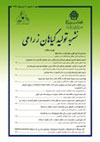The effect of seed aging on wheat emergence on the response of environmental stress
Author(s):
Abstract:
Emergence of crops is affected by environmental factors such as soil water, salinity and sowing and seed quality. The present study was conducted to evaluate the effect of seed aging (seed quality) on emergence of wheat under optimum (control) and stressful conditions including salinity (2 levels), drought (2 levels) and deep sowing depth (physical stress). Seeds (cv. ‘Zagros’) were kept at a high temperature (43°C) and high relative humidity (90-95%) to create different classes of seed aging. Factorial combinations of 5 seed aging treatments (0, 48, 72, 96 and 144 h accelerated aging periods) and 6 levels of environmental factor were treatments of the experiment. Results indicated that maximum and rate of emergence reduced significantly with increase in the duration of accelerated aging in all environmental factors. Decreasing slope of maximum emergence for control, medium drought, severe drought, sowing depth, medium salinity, severe salinity were 0.192, 0.304, 0.152, 0.296, 0.221 and 0.184, respectively. Decreased percent of emergence in 0 h compared with 48, 72, 96 and 144 h at control environment condition were 9.10, 5.68, 21.59 and 27.27 respectively. But, this decreased percent of emergence increased in stress conditions. Overall, seeds of high vigor had better emergence than low vigor seeds in stress and they had higher maximum emergence and rate.
Language:
Persian
Published:
Electronic Journal of Crop Production, Volume:2 Issue: 2, 2009
Page:
43
https://magiran.com/p647259
سامانه نویسندگان
مقالات دیگری از این نویسنده (گان)
-
Crop Yield and Growth Trait Response to Varied Nitrogen Fertilization and Pre-Planting of Cover Crops in Rice (Oryza sativa L.)
Hannaneh Mehdipour, *, Samaneh Hasanzadeh, Asieh Siahmarguee
Journal of Agricultural Science and Sustainable Production, -
Changing carbon sequestration potentials based on different land uses; A review
Hossein Kazemi *, Hermann Klug, Samane Bakhshandeh,
Journal of Emergy, Life Cycle and System Analysis in Agriculture, Summer- Autumn 2022



